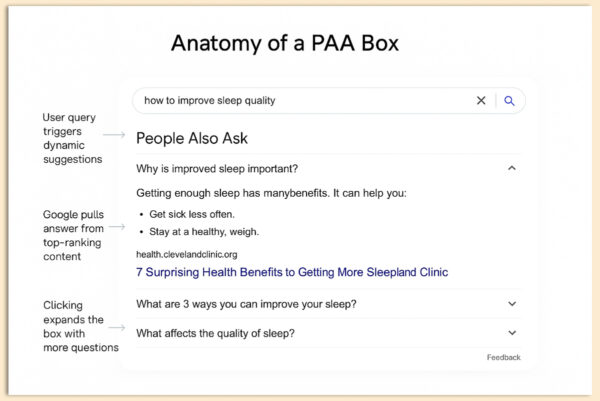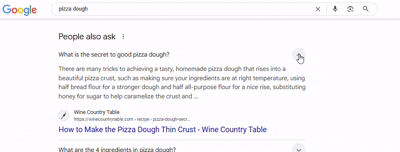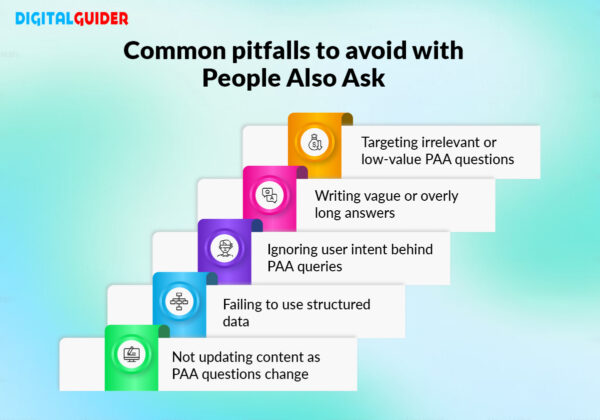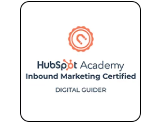Ever wondered how some brands magically appear in Google’s “People Also Ask” boxes—snagging premium real estate without even being the #1 result?
You’re not alone. These expandable question snippets are more than just helpful—they’re SEO gold.
If you’re a content creator, marketer, or business owner aiming to boost visibility, increase click-through rates, and appear where the action is happening, ranking in these smart SERP features should be at the top of your SEO strategy.
In fact, studies show that content featured in PAA boxes enjoys a click-through rate up to 30% higher than that of regular snippets.📈

That’s exactly what this blog will cover, from understanding how Google chooses questions to optimizing your content using semantic SEO, structured data, and the art of anticipating user intent.
In this guide, you’ll learn:
- What PAA boxes are and why they matter?
- How to optimize your content to rank in them?
- SEO tactics like LSI keywords & schema markup
Ready to claim your space in Google’s interactive question carousel?
Let’s dive in and make your content the answer everyone’s looking for.
What are ‘People Also Ask’ Boxes, and Why Should You Care?
You’ve probably come across expandable question boxes right on top or middle of a Google result page. These are known as “People Also Ask” (PAA) boxes, and they’re more powerful than they look.
What is the ‘People Also Ask’ Box?
The People Also Ask (PAA) box is a dynamic Google Search Feature that displays a list of related questions based on your original query. When a user clicks on one of these questions, it expands to reveal a brief answer pulled from a relevant web page, with a clickable link to that source for more in-depth information.
These answers may appear as:
- Simple paragraphs
- Bulleted or numbered lists
- Tables or charts
- Even images and videos
👉 And the most interesting part?
Each time you click on a question, more related questions load in real-time, creating a nearly infinite loop of user intent discovery.
Google is giving you a cheat sheet on what your audience really wants to know.
Why Should You Care About People Also Ask for SEO?
Whether you’re a blogger, business owner, or SEO strategist, PAA is a goldmine for content optimization.
Ranking in the PAA section can:
- Boost your visibility—even if you’re not the #1 result
- Attract highly targeted traffic actively searching for answers
- Help you dominate voice search and long-tail queries
- Reveal hidden keyword opportunities through real user questions
| And here’s the kicker: You don’t need to rank first on the page to appear in PAA—just offer a clear, well-structured answer to a question users are asking. |
How Can You Find “People Also Ask” Questions?
If you want your content to rank in Google’s People Also Ask (PAA) boxes, the first step is simple: know what questions your audience is asking.
Luckily, there are multiple ways to know these real-user queries—both manually and with tools.
1. Use Google Search (Manual Method)
Just type your main keyword into Google and watch the PAA box populate with related queries.

- Clicking one question reveals more
- Helps your discover follow-up intent
- Great for building FAQ sections or subheadings.
Tip: Use an incognito window and vary your search terms to explore more PAA variations.
2. Leverage ‘People Also Ask’ Tools
These tools help you extract, organize, and scale PAA questions.”
- AlsoAsked.com 🔍
Visualizes the branching logic of PAA questions - AnswerThePublic 💡
Maps out questions, prepositions, comparisons, and more - Semrush’s Keyword Magic Tool 📊
Filters keywords with PAA - SEO Minion (Chrome Extension) 🧪
Shows PAA data on live SERPs and allows easy exports
| These People Also Ask tools are perfect for SEOs, content marketers, and bloggers who want ot scale PAA research.✅ |
3. Use Google’s ‘People Also Ask’ to Build Content Silos
Each question in a PAA box is a doorway into a deeper subtopic.
Use them to:
- Structure your content hierarchically (main topic→sub-questions)
- Write in a way Google loves: question + concise answer + elaboration
- Increase chances of ranking for multiple long-tail keywords
Pro Tip:
Use targeted PAA queries as your H2 or H3 headers, then answer them directly underneath. That’s how Google decides whether your content is the best fit for the PAA box.
How Do You Optimize Content for “People Also Ask”?
Ranking in Google People Also Ask (PAA) boxes is one of the smartest ways to boost your visibility on the search engine results pages (SERPs). But it’s not just about guessing questions, it’s about understanding intent, formatting your content precisely, and making it genuinely useful.
Here’s how you can optimize your content to appear in these highly-clickable PAA boxes and attract better organic traffic.
1. Answer users’ Questions Directly
Google values plain and accurate information. So do your readers. If someone asks a question, don’t beat around the bush; get straight to the answer.
Why this matters:
- Google pulls direct, well-structured answers for PAA
- Readers appreciate fast, helpful information, especially on mobile.
How to do it?
- Begin with a clear, 1-2 sentence summary answer under the heading
- Avoid fluff, filler intros, or indirect phrasing
- Follow with context, examples, or visuals
For example, let’s say there’s a query
Q: “How to find People Also Ask questions?”
Then your answer should be straight, clear, and to the point, such as
A: “You can find People Also Ask questions by searching your target keyword in Google and examining the expandable PAA box. Tools like AlsoAsked and Semrush also help uncover related PAA queries.”
2. Provide a Concise Answer Immediately After the Heading
Google prefers answers that are 40-60 words long, highly relevant, and placed right below the question. If you bury the answer under fluff or off-topic content, Google is less likely to select your content.
Best practice format”
- Write a short paragraph (1-3 lines) directly answering the question.
- Follow it with more explanation, examples, or context.

This structure appeals to both Google’s snippet extraction logic and the reader’s need for immediate value.
3. Use Snippet-Friendly Formats
The PAA box often features structured responses like:

- A single paragraph (for definitions)
- Bulleted or numbered lists (for processes or tools)
- Tables (for comparisons or data points)
Why it matters:
These formats help Google extract your content as a snippet. Even better, they make the content easier to scan, improving readers’ engagement and dwell time.
| Tip: Identify what format Google is currently using for your target PAA queries and match it. |
4. Incorporate Schema Markup where Applicable
While schema markup doesn’t guarantee PAA placement, it helps Google understand the context and structure of your content.
Recommended Schema Types:
- FAQPage for Q&A-style content
- HowTo for step-by-step guides
- Article for0 in-depth blog content
Tools to help:
Use Google’s Rich Results Test or schema generator to implement this without coding.
5. Match the User’s Search Intent Precisely
Search intent is the cornerstone of SEO. If a user is looking for a definition, provide, not a product pitch. If they’re seeking a step-by-step guide, don’t provide a summary without details.
How to do it:
- Understand the query type (informational, navigational, transactional)
- Stay focused on answering the query before offering additional insights.
- Avoid vague intros or salesy language early in your answers.
Matching intent builds trust with both users and Google.
6. Keep Monitoring and Refining Your Content
Google regularly updates SERPs, and what ranks today may not hold tomorrow. To keep your content in the PAA box:
- Use Google Search Console to identify question-based queries that drive traffic.
- Review your content’s snippet presence with tools like Semrush or Ahrefs
- Refresh outdated sections and re-optimize headers based on new PAA trends.
Content optimization is not one-time work—it’s ongoing.
Bonus Tip:Add a Targeted FAQ Section Using PAA DataAn FAQ section built from real PAA questions is a smart way to:
Use subheadings (H3 or H4) and write 2-3 line responses to make it crawlable and useful. |
How Can You Rank in “People Also Ask”?
Getting your content featured in Google’s PAA boxes is not just about answering questions, it’s about answering the right questions, the right way. To improve your chances of being selected for a PAA result, here are key strategies that align with Google’s content preferences and search behavior trends.
1. Target High-Value, Low-Competition PAA Questions
Not every question in the PAA section is worth pursuing. Some are too broad, others already have authoritative sources occupying the spot.
Here’s what to do:
- Use tools like AlsoAsked, Semrush, or Ahrefs to pull relevant PAA questions for your PAA questions for your topic.
- Prioritize long-tail questions, these often have lower competition but strong intent.
- Consider the user journey: Choose questions that align with what users want to know before making a decision.
Tip: Search your main keyword on Google and note the initial 3-5 PAA boxes that appear; these are often the most valuable and get the highest click-throughs.
2. Write High-Quality, Authoritative Content
Google’s algorithm favors content that doesn’t just answer a query, it trusts content written by those who know what they’re talking about, in a format that’s easy to understand and reliable.
Which ultimately aligns with Google’s E-E-A-T framework.
Best practices:
- Use subheadings that mirror PAA questions (e.g., How to rank in People Also Ask?)
- Give direct, concise answers followed by supporting context.
- Cite trustworthy sources when needed and offer useful internal links.
Remember, PAA answers are often pulled from content that reads like it’s written for users, not algorithms.
3. Updated Content Regularly Based on Evolving Queries
Google updates the questions that appear in the PAA box frequently. What worked six months ago may no longer match user behavior.
Why does this matter?
Content freshness is a ranking factor, especially for question-based features like PAA.
Update strategy:
- Revisit your existing blog posts quarterly
- Use Google Search Console to track new question-based queries that lead users to your site.
- Refresh outdated statd, tweak answers to align with current formats, and add newly surfaced PAA questions.
4. Cover Related Questions to Increase Visibility
Answering just PAA questions is good, but covering a cluster of related questions is better.
How it helps:
- Increases your chances of appearing in multiple PAA boxes for related searches.
- Encourages users to stay on your page longer (boosting dwell time and engagement signals)
For example, if your blog is about “SEO basics,” include-inspired sections like:
- What is SEO, and how does it work?
- Why SEO is important for startups?
- How long does SEO take to show results?
This comprehensive structure signals to Google that your content is topically complete.
What Are the Best Tools for “People Also Ask” Research?
To successfully rank in PAA boxes, you need tools that help uncover real user questions, evaluate competition, and integrate findings into your SEO workflow.
From free to paid solutions, here is a comparison table of the best tools to power your strategy.
| Tool | Free/Paid | Best For | Key Features | Integrates With |
| Google Search Manual | Free | Beginners, quick research | Real-time PAA questions from live SERPs | N/A |
| AnswerThePublic | Free & Paid | Content Brainstorming | Visual keyword clustering, PAA-style queries | Can export to CSV or integrate manually |
| AlsoAsk | Paid | PAA tree mapping | Maps question chains like Google’s PAA box; exports question trees | CSV export integrates with planning tools |
| Semrush | Paid | Keyword research + content planning | Keyword Magic Tool, SERP features, filters for PAA questions | Google Analytics, GSC, Looker Studio |
| Ahref | Paid | SERP & keyword strategy | SERP overview, PAA question finder, keyword difficulty, traffic potential | Google Search Console, internal dashboard |
What Mistakes Should You Avoid with “People Also Ask”?

TL;DR
If you’re serious about boosting your SEO visibility, ranking in Google’s People Also Ask boxes is a strategy you can’t ignore. These dynamic SERP features provide a direct line to user intent, enabling you to drive more qualified traffic, enhance topical authority, and answer the real questions users are asking.
By:
- Choosing the right PAA questions
- Writing with clarity, structure, and authority
- Using effective research tools
- Avoiding common mistakes like vague answers or outdated content
…you position your content to show up where it matters most, right when users are actively searching.
Want help building a content strategy that gets you featured in PAA boxes? Let Digital Guider help you turn your content into a high-performing asset that ranks and resonates.
FAQ – People Also Ask
Q1. Do I need to rank #1 in Google to appear in PAA boxes?
A1. No. If your content directly answers a PAA question clearly and accurately, Google can still feature it.
Q2. How long does it take to show up in a PAA box?
A2. It varies. Some content may appear within days, while others take weeks.
Q3. Can PAA boxes increase traffic even if my site is new?
A3. Yes. If your content is useful and well-formatted, it can outperform more established sites in this feature.
Q4. Is there a risk of losing my spot in a PAA box?
A4. Yes. Google updates results regularly. Keep your answers updated and aligned with user intent.
Q5. Should I optimize every blog for PAA?
A5. Not necessarily. Prioritize pages that target question-based queries or where gaining visibility through PAA can support your SEO goals.
Q6. What’s the ideal word count for a PAA answer?
A6. 40–60 words is the sweet spot. Google favors short, clear answers. Use bullet points or steps if the query calls for it.
Q7. Do videos or images help with PAA rankings?
A7. While PAA mostly features text, sometimes images and even YouTube videos are shown. Embedding relevant visuals can enhance user experience, even if not directly boosting your chances in PAA.
Q8. How often should I update content for PAA rankings?
A8. Aim to refresh key content every 3–4 months. This keeps your answers aligned with current search trends and maintains your chances of staying in the box.
Q9. Can PAA help with voice search?
A9. Absolutely. Since PAA responses often resemble how people ask questions out loud, optimizing for these can help you rank for voice assistants like Siri or Google Assistant.
Q10. Should small businesses care about People Also Ask?
A10. Yes. Ranking in PAA can boost your visibility locally and attract leads without needing a massive SEO budget.







